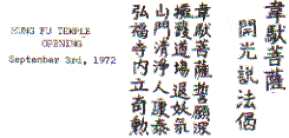Sanskrit
![]()
Ardhatrayodasabhir Bhiksusatair
"Twelve-hundred-fifty Bhiksus"
--By Bhiksuni Heng Hsien
The text presented in the last lesson established the
assembly in which the Shorter Amitabha Sutra was spoken;![]() mahata
bhiksu-sanghena sardham, "together with a great gathering of Bhiksus." Now the text continues:
mahata
bhiksu-sanghena sardham, "together with a great gathering of Bhiksus." Now the text continues:![]() ardhatrayodasabhir bhiksusatair, "twelve-hundred-fifty Bhiksus,"
further characterizing the Bhiksusangha by giving the number of Bhiksus
that made it up. In this lesson we will see something of the workings of
Sanskrit numbers, and be introduced to two varieties of endings for the now
familiar "with" case, those used in the plural.
ardhatrayodasabhir bhiksusatair, "twelve-hundred-fifty Bhiksus,"
further characterizing the Bhiksusangha by giving the number of Bhiksus
that made it up. In this lesson we will see something of the workings of
Sanskrit numbers, and be introduced to two varieties of endings for the now
familiar "with" case, those used in the plural.
Very literally the phrase breaks down this way: minus-half-three-tens-with Bhiksu-hundreds-with. "With" is called
for by the preposition sardham which occurred in the previous phrase and which
means "together with."
-bhir These are the two possible endings in the plural, which are
translated as ¡§with.¡¨
-air
The final ¡Vr really represents an ¡Vs,
and so in their basic form the endings
are:
-bhis The final ¡Vs however, is pronounced in various ways, depending on
the following sound,
-ais and these endings might also show up as:
-bhih -aih You want to be able to recognize them in the midst of their
transformations.
In Classical Sanskirt, -bhis is used with all nouns except those whose
stem ends in ¡Va, which take ¡Vais. However, in popular speech, which
Buddhist teachings reflect, -bhis may be used with any noun, and here it
is added to the word dasa- even though dasa has a stem in ¡Va.
![]() ardha,
means ¡§half.¡¨ In making up the number 1250, you must understand that this
¡§half¡¨ is a quantity to be subtracted.
ardha,
means ¡§half.¡¨ In making up the number 1250, you must understand that this
¡§half¡¨ is a quantity to be subtracted.![]() trayas,
means ¡§three.¡¨ The number three is
trayas,
means ¡§three.¡¨ The number three is![]() tri,
and takes endings like a noun. Trayas is plural masculine in the subject
function. The ending ¡Vas, which indicates all this, is itself pronounced and
written ¡Vo before the following sound, as frequently happens to final ¡Vas.
Did you think that Sanskrit was easy?
tri,
and takes endings like a noun. Trayas is plural masculine in the subject
function. The ending ¡Vas, which indicates all this, is itself pronounced and
written ¡Vo before the following sound, as frequently happens to final ¡Vas.
Did you think that Sanskrit was easy?
![]() dasa,
means ¡§ten.¡¨ Trayodasa means ¡§three plus ten,¡¨ or ¡§thirteen,¡¨ but
ardha, ¡§half,¡¨ is subtracted, and so ardhatrayodasa amounts to
¡§thirteen-minus-half¡¨ or ¡§twelve and one half.¡¨ As if this were not bad
enough, the whole compound word is then used to multiply the following word
which is made up of:
dasa,
means ¡§ten.¡¨ Trayodasa means ¡§three plus ten,¡¨ or ¡§thirteen,¡¨ but
ardha, ¡§half,¡¨ is subtracted, and so ardhatrayodasa amounts to
¡§thirteen-minus-half¡¨ or ¡§twelve and one half.¡¨ As if this were not bad
enough, the whole compound word is then used to multiply the following word
which is made up of:![]() Bhiksu,
which means a Buddhist monk, and
Bhiksu,
which means a Buddhist monk, and![]() sata,
which means a ¡§hundred.¡¨ Multiplying one hundred by twelve and one half, we
come out with twelve-hundred-fifty monks in all.
sata,
which means a ¡§hundred.¡¨ Multiplying one hundred by twelve and one half, we
come out with twelve-hundred-fifty monks in all.
These 1250 Bhiksus followed
the Buddha wherever he went, so great was their gratitude to the Buddha for
teaching living beings. Whenever the Buddha spoke for teaching living beings.
Whenever the Buddha spoke Dharma they were present to protect the Dharma
Assembly, even though they already understood the teaching.
************************************************************************************************

Opening the Light for Wei T¡¦ou Bodhisattva
Bodhisattva Wei T¡¦ou who has made deep vows
To guard the Bodhimandala and dispense strange vapors,
To keep the temple clear and pure the people in good health.
Now stands in Hung Fu Temple giving rare and loyal services.
Old Wei works too hard, standing there all day long, so I¡¦ll give him a high hat. Why does he work so hard standing there holding his jeweled pestle like a cop? It¡¦s because of a vow he made to protect the Bodhimandala from all demons and weird creatures. When they appear, glaring he swings his club at them and they run away. Thus the people in the temple are healthy, happy, and receive good fortune.